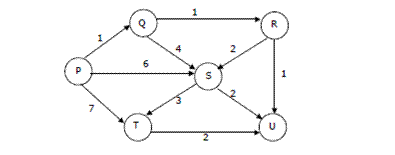GATE-CS-2004
Question 41
What does the following algorithm approximate?
C
(Assume m > 1, e > 0).
x = m;
y = 1;
while (x - y > e)
{
x = (x + y)/2;
y = m/x;
}
print(x);
Question 42
Consider the following C program segment
c
The value returned by the function DoSomething when a pointer to the root of a non-empty tree is passed as argument is
struct CellNode
{
struct CelINode *leftchild;
int element;
struct CelINode *rightChild;
}
int Dosomething(struct CelINode *ptr)
{
int value = 0;
if (ptr != NULL)
{
if (ptr->leftChild != NULL)
value = 1 + DoSomething(ptr->leftChild);
if (ptr->rightChild != NULL)
value = max(value, 1 + DoSomething(ptr->rightChild));
}
return (value);
}
Question 43
Question 44
Consider the grammar with the following translation rules and E as the start symbol.
E → E1 # T { E.value = E1.value * T.value }
| T{ E.value = T.value }
T → T1 & F { T.value = T1.value + F.value }
| F{ T.value = F.value }
F → num { F.value = num.value }
Compute E.value for the root of the parse tree for the expression: 2 # 3 & 5 # 6 & 4.
Question 45
Consider the following set of processes, with the arrival times and the CPU-burst times given in milliseconds
Process Arrival Time Burst Time
P1 0 5
P2 1 3
P3 2 3
P4 4 1
What is the average turnaround time for these processes with the preemptive shortest remaining processing time first (SRPT) algorithm ?
Question 46
Consider a system with a two-level paging scheme in which a regular memory access takes 150 nanoseconds, and servicing a page fault takes 8 milliseconds. An average instruction takes 100 nanoseconds of CPU time, and two memory accesses. The TLB hit ratio is 90%, and the page fault rate is one in every 10,000 instructions. What is the effective average instruction execution time?
Question 47
Consider two processes P1 and P2 accessing the shared variables X and Y protected by two binary semaphores SX and SY respectively, both initialized to 1. P and V denote the usual semaphore operators, where P decrements the semaphore value, and V increments the semaphore value. The pseudo-code of P1 and P2 is as follows : P1 :
While true do {
L1 : ................
L2 : ................
X = X + 1;
Y = Y - 1;
V(SX);
V(SY);
}
P2 :
While true do {
L3 : ................
L4 : ................
Y = Y + 1;
X = Y - 1;
V(SY);
V(SX);
}
In order to avoid deadlock, the correct operators at L1, L2, L3 and L4 are respectively
Question 48
A Unix-style i-node has 10 direct pointers and one single, one double and one triple indirect pointers. Disk block size is 1 Kbyte, disk block address is 32 bits, and 48-bit integers are used. What is the maximum possible file size ?
Question 49
The relation scheme Student Performance (name, courseNo, rollNo, grade) has the following functional dependencies:
name, courseNo → grade rollNo, courseNo → grade name → rollNo rollNo → nameThe highest normal form of this relation scheme is
Question 50
Consider the relation Student (name, sex, marks), where the primary key is shown underlined, pertaining to students in a class that has at least one boy and one girl. What does the following relational algebra expression produce? (Note: r is the rename operator).
 The condition in join is "(sex = female ^ x = male ^ marks ≤ m)"
The condition in join is "(sex = female ^ x = male ^ marks ≤ m)"
 The condition in join is "(sex = female ^ x = male ^ marks ≤ m)"
The condition in join is "(sex = female ^ x = male ^ marks ≤ m)"There are 90 questions to complete.
Last Updated :
Take a part in the ongoing discussion
